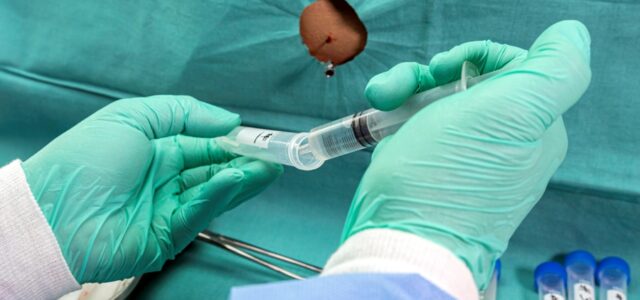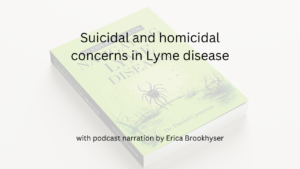Call for your appointment today 914-666-4665 | Mt. Kisco, New York

Welcome to another Inside Lyme Podcast with your host Dr. Daniel Cameron. In this episode, Dr. Cameron will be discussing a case which examines the diagnostic value of a lumbar puncture in Lyme neuroborreliosis.
The case was first described by Portales-Castillo and colleagues in the journal Cureus in a paper entitled “To Lumbar Puncture or Not to Lumbar Puncture.” The authors presented a case of “early disseminated Lyme neuroborreliosis with manifestations of facial palsy and painful radiculoneuritis as determined by clinical and serological criteria.”¹
A 61-year-old woman was admitted to the hospital with an inability to close her left eye and an odd sensation on part of her face. She presented with erythematous raised circled rash and swelling on the base of the index finger of her right hand.
She thought she might have been bitten by a spider two days prior and was therefore treated with cephalexin for a presumed cellulitis.
Three weeks later, she started to develop posterior dull neck pain, along with bilateral arm pain and arm weakness. Her symptoms progressed to the point where she could no longer comb her hair.
CLICK BELOW TO WATCH VIDEO DISCUSSION OF THE CASE
CLICK BELOW TO LISTEN TO PODCAST
“The pain later became associated with progressive arm weakness, which continued to progress over the following three weeks up to the point where she could not comb her hair,” the authors wrote.
The woman then developed Bell’s palsy. A Lyme disease IgM Western blot test was positive, consistent with acute Lyme disease.
“Our case aimed to highlight the controversy on the diagnostic utility of cerebrospinal fluid (CSF) analysis in certain presentations of [Lyme neuroborreliosis].”
A spinal tap was recommended but not performed. “She politely declined as she wondered if the treatment decision would be altered by the results of an invasive procedure,” wrote the authors.
Instead, she was treated empirically for Lyme disease.
“After discussion with the neurology and infectious disease consultants, the diagnosis of early disseminated Lyme neuroborreliosis manifesting as painful radiculoneuritis, motor weakness, and facial nerve palsy (so-called Bannwarth syndrome) was considered a strong possibility based on her clinical presentation and serologic criteria,” wrote the authors.
The woman’s Bell’s palsy and pain resolved after 4 weeks of treatment with doxycycline, prednisone (60 mg for 5 days) and eye drops. In addition, there was marked improvement in her weakness.
At her two-week follow-up appointment, the woman reported having a “complete resolution of her facial weakness and pain along with marked improvement in her weakness, which did not recur after successful course completion,” the authors wrote.
Spinal tap controversy
“[Lyme neuroborreliosis] remains a challenging diagnosis and often warrants spinal fluid analysis, particularly in the context of acute meningitis,” wrote the authors. “However, the ultimate decision to obtain a lumbar puncture (LP) in such patients with facial palsy and peripheral neurological symptoms remains controversial.”
Guidelines are divided over whether to take an individualized approach for spinal fluid analysis or relying on spinal fluid analysis for the diagnosis.
Cerebral spinal fluid (CSF) tests are not reliable, given that the increase in the number of white cells in the CSF (called pleocytosis) can be raised from other illnesses.
A finding of an elevated B. burgdorferi antibody in the spinal fluid has been helpful. However, the ration of CSF: serum antibodies should be 1.3 or higher. In other words, the CSF antibodies must be 30% higher than the serum antibodies. In some cases, the CSF B. burgdorferi polymerase chain reaction (PCR) may be positive.
The sensitivity of the spinal tests can be low. Only 1 in 27 patients with neurologic Lyme disease had a pleocytosis and that was only 7 cells. One other patient with neurologic Lyme had CSF antibodies but the ratio was only 1. Other studies have shown higher sensitivities. Other CSF tests have been examined including the CXCL13 chemokine biomarker in CSF.
“To Lumbar Puncture or Not to Lumbar Puncture”
A spinal tap may be important to rule out alternative diagnoses. “The need for an LP in suspected cases of LNB remains a clinical decision that needs to be tailored to the specific clinical situation, favored when diagnostic uncertainty is present, and potentially spared when the clinical suspicion for LNB is high,” wrote the authors.
The following questions are addressed in this Podcast episode:
1. What is neurologic Lyme disease?
2. What were the neurologic findings for this patient?
3. What is Bannwarth syndrome?
4. What is a spinal tap?
5. Why is a spinal tap useful and what is the accuracy?
6. What are the findings in a spinal tap of someone with neurologic Lyme disease?
7. What are problems with reliability of the test?
8. Do you discuss “To Lumbar Puncture or Not to Lumbar Puncture” with your patients?
Thanks for listening to another Inside Lyme Podcast. Please remember that the advice given is general and not intended as specific advice to any particular patient. If you require specific advice, please seek that advice from an experienced professional.
Inside Lyme Podcast Series
This Inside Lyme case series will be discussed on my Facebook page and made available on podcast and YouTube. As always, it is your likes, comments, and shares that help spread the word about this series and our work. If you can, please leave a review on iTunes or wherever else you get your podcasts.
References:
- Portales-Castillo C A, Said M (September 14, 2021) To Lumbar Puncture or Not to Lumbar Puncture: A Case of Lyme Neuroborreliosis. Cureus 13(9): e17970. doi:10.7759/cureus.17970




Thank you for this broadcast Dr. Cameron. It seems that even three diagnostic positives were not enough to get a correct treatment. If we consider suspected spider bite, as I once had just before the start of all my symptoms, that should also be a confirmation.
Lest we diagnose to death, there must be moore education about treatment. Specifically reducing the firewalls between allopathic and naturopathic, pharmacy and politics.
When these fiefdoms begin talk WITH each other, to work on what works, only then will patients with late, stage Boriella and co-infections can begin to have hope.